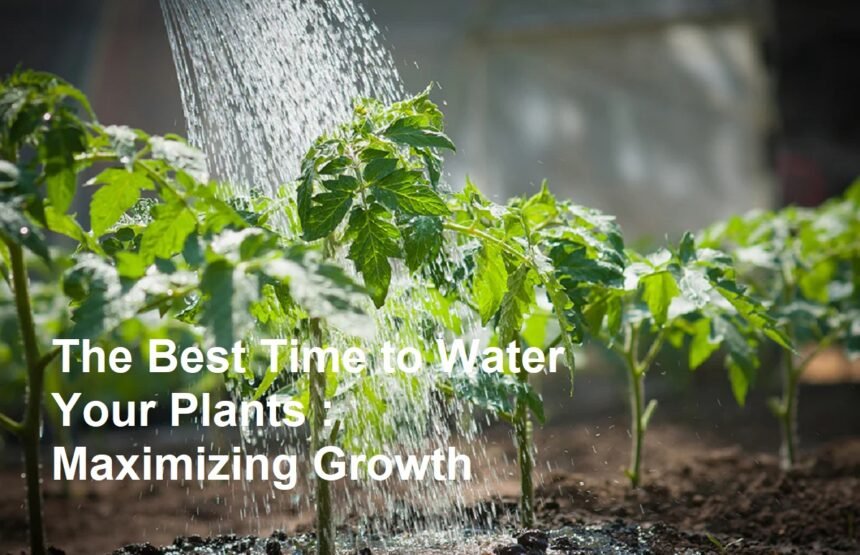Introduction
Knowing when to water your plants is just as crucial as knowing how much to water. Getting the timing right can mean the difference between vibrant, thriving greenery and struggling, stressed foliage. While plant needs vary, science and experience point to early morning as the universally optimal time for watering most plants. Here’s why:
1. The Golden Hour: Early Morning (Before 10 AM)
- Cooler Temperatures:Mornings are typically cooler, reducing immediate evaporation. This gives water time to soak deeply into the soil, reaching the root zone where plants need it most.
- Preparing for the Day:Watering in the morning hydrates plants before the sun’s intensity peaks and temperatures rise. This helps them withstand heat stress and maintain turgor pressure (rigidity in stems and leaves) throughout the day.
- Optimal Absorption:Roots are most active in the early morning, efficiently taking up water and dissolved nutrients.
- Disease Prevention:Watering early allows foliage to dry quickly once the sun comes up. Wet leaves overnight (from evening watering) create a haven for fungal diseases like powdery mildew and blight. Morning sun helps dry leaves rapidly.
2. The Second-Best Option: Late Afternoon/Early Evening (Only if Necessary)
- Use Case:Morning watering isn’t always practical. If you must water later, aim for late afternoon or very early evening, only when there’s enough sunlight left for leaves to dry completely before nightfall.
- Pros:Soil temperatures are cooler than midday, reducing evaporation loss compared to watering in the heat.
- Cons (The Big Risk):The major drawback is the potential for leaves to stay wet overnight, significantly increasing the risk of fungal and bacterial diseases. This is especially problematic in humid climates or for dense, low-growing plants. Avoid watering so late that leaves are still damp at dusk.
3. The Worst Time: Midday (Avoid!)
- High Evaporation:Watering during the peak heat of the day (roughly 10 AM – 4 PM) leads to massive water loss through evaporation before it even reaches the roots. This is wasteful and inefficient.
- Leaf Scorch:Water droplets on leaves can act like tiny magnifying glasses under intense sun, potentially scorching the foliage.
- Shock Potential:Pouring cold water on hot soil or stressed plants can cause thermal shock, further stressing them.
Factors That Can Modify the Best Time
- Climate:
- Hot & Dry Climates:Morning watering is absolutely critical. A second light watering in the late afternoon might be needed for very thirsty plants or containers, but prioritize soil watering over foliage.
- Cool & Humid Climates:Morning watering remains best to combat fungal issues. Evening watering is highly discouraged due to prolonged moisture.
- Plant Type:
- Succulents & Cacti:Highly susceptible to rot. Water deeply but infrequently, only in the morning, allowing soil to dry completely between waterings. Avoid evening watering.
- Seedlings & Young Plants:Have shallow roots and dry out quickly. May need gentle morning watering and potentially a light check-in later in the day if extremely hot/dry, but avoid wetting foliage late.
- Vegetables (especially fruiting types like Tomatoes):Consistent morning watering is key. Wet foliage overnight promotes blight.
- Tropical Plants:Often enjoy humidity but still benefit from morning watering to prevent crown/stem rot. Misting (if done) should also be in the morning.
- Container vs. In-Ground:
- Containers/Pots:Dry out much faster than garden soil. May need watering more than once a day in extreme heat, but always do the main watering in the morning. A late afternoon “sip” might be needed if the soil is bone dry and the plant is wilting, but avoid soaking foliage.
- Watering Method:
- Drip Irrigation/Soaker Hoses:These deliver water directly to the soil at the root zone, minimizing water on leaves. This makes them excellent for any time of day, but morning is still most efficient (less evaporation) and aligns best with plant uptake cycles.
- Overhead Sprinklers:Wet foliage heavily. Must be used in the morning to allow leaves to dry quickly. Using sprinklers in the evening is a recipe for disease.
Key Principles for Effective Watering
- Water Deeply and Infrequently:Encourage deep root growth by soaking the soil thoroughly, then letting the top few inches dry out before watering again (check soil moisture with your finger!). Shallow, frequent watering promotes weak surface roots.
- Focus on the Roots:Aim water at the soil base, not the leaves (unless misting specific humidity-loving plants in the morning).
- Observe Your Plants:Wilting can mean too dry OR too wet (root rot). Check the soil! Yellowing leaves can also indicate overwatering. Learn your specific plants’ signals.
- Adjust for Seasons:Plants need less water in cool seasons or dormant periods. Increase frequency during hot, dry, or windy weather.
Conclusion
While life sometimes forces adjustments, watering in the early morning is the scientifically-backed best practice for most plants in most situations. It maximizes water efficiency, ensures deep root hydration, prepares plants for the day’s heat, and critically, minimizes the risk of devastating fungal diseases by allowing foliage to dry quickly. Making morning watering your consistent routine is one of the simplest yet most effective steps you can take towards a healthier, more resilient garden. Your plants will thank you with lush growth and vibrant blooms!












